Labeling
Product Labeling and Use of Health and Nutrition Claims
One important means of promoting healthy diets, and addressing obesity and undernutrition, is to provide consumers with accurate, comprehensive, and readily understandable information about the nutritional composition and potential health benefits of what they eat. This can promote better nutrition by helping consumers choose appropriate products to manage their weight and assist in preventing or addressing diet-related chronic disease, as well as raise awareness of products that will target micronutrient deficiencies.
This category assesses companies’ approaches to product labeling and use of health and nutrition claims, particularly with respect to the consistency of their application across product portfolios and in different markets, and accordance with international standards.
Category F consists of two criteria:
- F1 Nutrition Labeling
- F2 Health and Nutrition claims
To perform well in this category, a company should:
- Adopt, publish, and fully implement a global policy on nutrition labeling that commits to provide information on all key nutrients in a way that is easy for consumers to understand. This includes information on portion size and nutrients as percentages of Daily Values (or equivalent) displayed appropriately in nutrition information panels on the back of packs and in interpretive format on the front of packs.
- Disclose the degree to which full labeling policy is implemented, at the level of markets with full roll-out.
- Define a labeling strategy and targets aimed at reducing food waste and provide examples.
- Adopt and publish a global policy on the use of health and nutrition claims that states that, in countries where no national regulatory system exists, such claims will only be placed on products if they are in full compliance with the relevant Codex standard.
- Adopt and publish a global policy on labeling that includes commitments to use nutrition or health claims on fortified products only when they meet relevant Codex standards and the WHO/FAO Guidelines on Food Fortification with Micronutrients.
Ranking on Labeling
- F1
- Product labeling
- F2
- Claims
- *
- Did not provide information to ATNI
Unilever takes first place in the rankings with an improved score of 8.5, rising three places since 2018. It is followed by Nestlé (8.4) and Mondelez (7.0) in second and third positions. Arla (increasing from 2.5 to 6.2) and PepsiCo (increasing from 2.6 to 6.1) show the most improvement in their ranks.
Category Context
Labeling is used on the packaging of food and beverage products to inform consumers about the nutritional composition of its contents, the product’s expiration date, and any additional health or nutritional messages, among others. It is of high importance that labels are presented in a format that consumers readily understand, and that confusion is avoided. Consumer research shows product labeling is highly appreciated and plays an important role in product choice, particularly in making healthier decisions and comparing the healthiness of products. The outbreak of the Covid-19 pandemic has seen a shift in product purchase as consumers have become more aware of their own health and wellness and seek healthier products. At the same time, the rise in e-commerce grocery shopping has accelerated the need for accurate online nutrition labeling and stronger regulations, to avoid the sharing of misinformation and monitor the use of health claim.
The nutritional content of the product is normally displayed in a table format back-of-pack (BOP) and includes information on nutrients, total energy, calories, salt and, depending on regulations, ingredients and the quantities of vitamins and minerals. Based on WHO/ FAO guidelines, it has been recommended recently that fiber and added sugars are also included to further highlight a product’s health credentials. Added sugars increase the level of energy (calories) in a product, while fiber aids in maintaining a healthy digestive tract.
Regarding front-of-pack (FOP) labeling research shows that interpretive labels, that include guidance or judgement on the healthiness of a product, are easier for consumers to understand than numeric labels that only provide quantitative information. Interpretive labels can help consumers better understand the nutrition content of products and make more informed healthy choices. The information is normally displayed in a format on the FOP that helps convey information to the consumer in a faster, unambiguous way. Examples of formats include color coded labels (e.g., traffic light system), grading labels, and warning labels (See Figure 2 and Box 1 below). In several countries, voluntary or mandatory FOP labeling schemes are in place, and research shows that around 30 countries have adopted one. Australia and New Zealand have developed their own government-endorsed system called the Health Star Rating (HSR) to help consumers choose foods that are higher in positive nutrients and lower in negative nutrients linked to obesity and diet-related chronic diseases (see Figure 2 and Box 1 below). This is the system ATNI uses for the independent product profile assessment, which is also part of this Global Index and shown in section B of this Index.
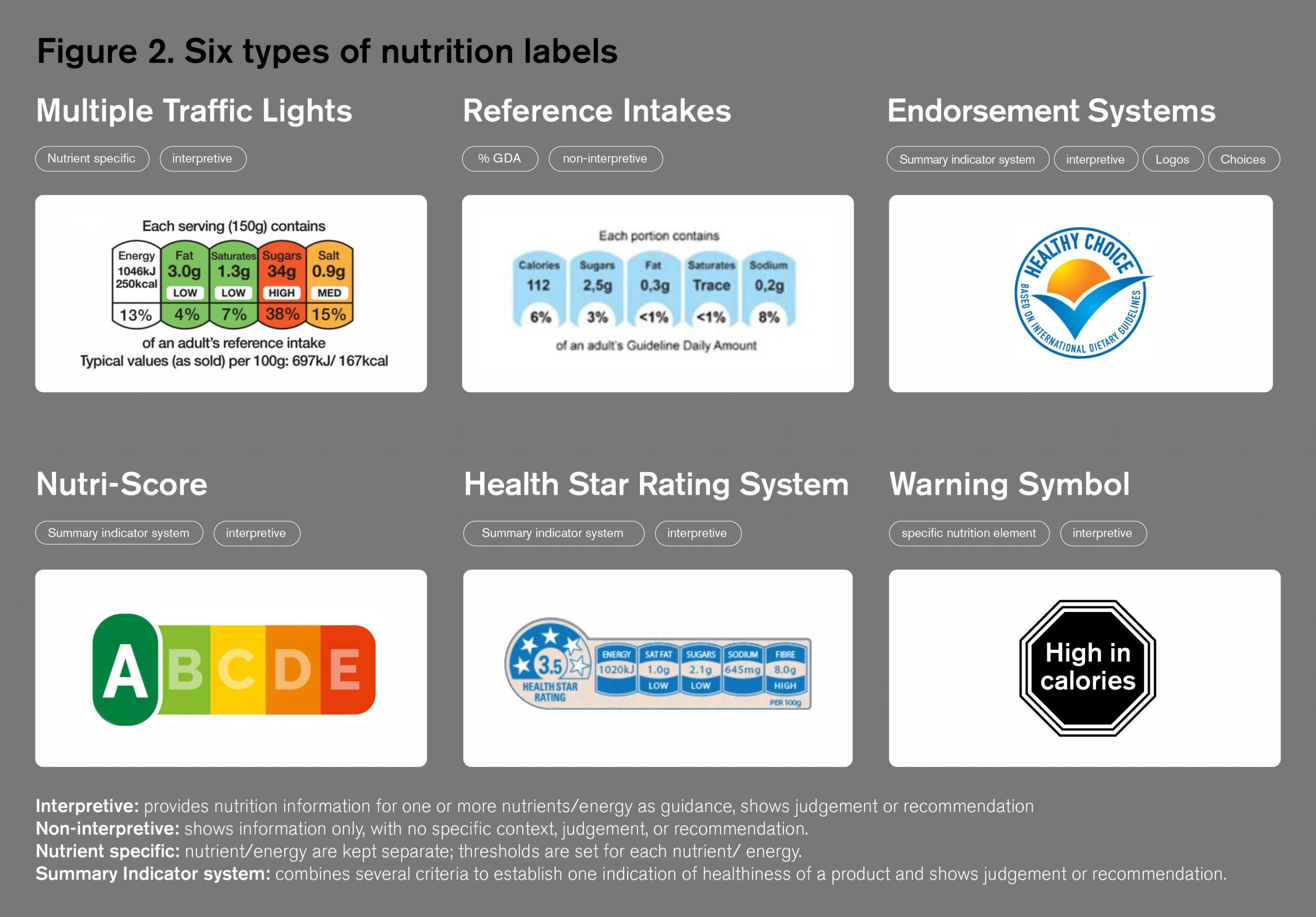
The use of one mandatory global labeling system has been discussed for many years, but no consensus has been reached about which system is the most effective. The European Union has been working on a harmonized system, and some food and beverage companies are supporting this. For example, France’s Nutri-Score, an independent, government-endorsed system introduced in 2017, conveys nutritional information via a colorful letter-based grading scale in the FOP. Six additional EU countries have already decided in favor of using the Nutri-Score system (See Figure 2 and Box 1 below).
Aside from this, regulations regarding labeling are important to protect the consumer and encourage fair practice in the food trade. They provide consumers with correct information on nutrition and shelf life, and guidance on product use. They also encourage manufacturers to formulate products of higher nutritional quality. Although a consensus on mandatory regulations has not been met, the Codex Alimentarius Guideline CAC/GL 2-1985 (set out by WHO/FAO1), was developed as a voluntary international standard and guideline, and set a precedent for food and beverages companies to follow. ATNI uses Codex as a framework and bases part of its assessment on companies’ commitment to follow these guidelines at a global level, in addition adhering to their own internal and industry regulations. The 2021 Index also assesses the degree to which companies confirm and disclose their approach to implementing these regulations. Guidelines for the use of nutrition and health claims are also set out by Codex CAC/GL 23-1997, and state that nutrition claims should be consistent with national policy in support of public health. Only nutrition claims that support national nutrition policy should be allowed.
As well as aiding consumers in decision making around health, labeling assists in reducing food loss and waste (FLW) by providing consumers with information on shelf life and how to use and store the product correctly. FLW is an important sustainability goal that links closely with access to nutrition, undernutrition, and the right to food. The less FLW there is, the greater the supply of food; which evidently impacts consumers’ access to nutrition. Food and beverage companies can prevent and reduce FLW in the production process, such as during the stages of the food chain in which they have most decision-making power: agricultural production, post-harvest handling and storage, and processing — downstream stages are not considered.
In this Category, ATNI assesses the food and beverage manufactures on their commitments, practices, and transparency regarding labeling, alongside the appropriate use of health and nutrition claims. ATNI uses tools to assess companies’ use of FLW tracking and prevention tools in their management systems.
Box 1. Overview of most used front of pack nutrition labels
Using interpretive FOP labeling that includes a qualification or recommendation on the healthiness of the food (e.g., by using color-coding, a traffic light system or a star or similar rating system) to convey the healthiness of a product is an effective method of informing consumers in a quick and easy to understand format. Six worldwide examples are shown in Figure 2.
Multiple traffic lights: The traffic light system was initially introduced by the UK Government in 2013 but it is currently a voluntary requirement for manufacturers under the Food Information Regulation. The traffic light labeling system informs consumers whether a product has high, medium, or low amounts of fat, saturated fat, sugars, and salt. Red implies that the product is high in a negative nutrient and should be eaten sparingly. Amber implies medium. The product should be eaten in moderation. Green means low. The greener the light a label displays, the healthier the food choice is. Reference Intake is shown in percentages.
Reference Intakes: This label shows the percentage of nutrients in a product that meets the Daily Reference Intake on a ‘’per portion basis’’ and provides information on the amount of fat, saturates, sugars, and salts the product adds to a person’s daily recommended intake. This labeling system is mostly used in the European Union.
Endorsement systems: The choice logo is a positive front-of-pack logo for food and beverage products and is the single food choice logo for The Netherlands. It considers the level of saturated fatty acids, trans fatty acids, added sugars, salt, and fiber, as compared with similar products within its category. Compared to a standard nutrition claim, which only refers to the amount of energy or of one single nutrient, it is a single statement about several nutrients. The healthy choice logo was developed by the Choices International Foundation and the Netherlands was the first country to authorize the Choices logo in 2006.
Health Star Rating system labels (HSR): This is a front-of-pack labeling system developed and government endorsed in Australia and New Zealand. It rates the overall nutritional profile of packaged food and assigns it a rating from half a star to 5 stars. The more stars, the healthier the choice.
Nutri-Score: The Nutri-Score, developed and government-endorsed in France, is a nutrition label that converts the nutritional value of products into a simple code consisting of 5 letters, each with its own color. Each product is awarded a score based on a scientific algorithm. This formula includes nutrients to limit (energy value and the quantity of sugars, saturated fats, and salt) and nutrients to increase (fiber, protein, fruit, vegetables and nuts, rapeseed oil, walnut oil, and olive oil).
Warning Systems: This is in the form of a black and white logo in the shape of a hexagon or octagon. It is used to highlight products with high content of energy, sugar, saturated fat, and sodium. The use of this warning label was implemented in Chile in June 2016 as part of the Chilean Food Labeling and Marketing Law.
Relevant changes in methodology
The underlying structure of the methodology for the Global Index 2021 has not significantly changed. Only some adjustments have been made to streamline it since the previous iterations of the Global Index. For Category F, these include:
- In 2018, the weight of Category F in the overall corporate profile score was 15%, whereas in this index it is 10%. This is because the independent product profile assessment is now included in the overall scoring algorithm and received a higher weighting.
- The scope of assessing FOP labeling commitments has evolved. Companies are now assessed on their commitments to not use any additional interpretive labeling on products which may confuse consumers or modify the effect of the mandatory labeling in countries where mandatory FOP labeling systems are not adopted. This includes the use of health warning labels.
- The scope of criterion F1 has expanded to include food loss and waste (FLW) indicators. Companies are assessed on their labeling strategies and targets aimed at reducing food waste and encouraged to disclose examples of this.
- In addition to assessing the appropriate use of claims (compliance with local or national guidelines), this category also looks at whether companies are using health and nutrition claims on products that are defined as healthy by a relevant Nutrient Profiling Models (NPM). Companies score highest when using a government-endorsed NPM.
- This category specifically assesses and scores companies on the percentage of products that companies provide nutrition information online for, accounting for country-specific differences in product compositions. Answer options range from less than 10% to more than 90% of products.
More details about the changes in the methodology can be found in the methodology section of this Index.
Global Index 2021 MethodologyKey Findings
- The average score for companies in Category F is 3.6 (shown in the first figure) which is slightly lower than in 2018 (3.8). This iteration of the index has seen the incorporation of new indicators (using an NPM prior to placing health claims and assessing FLW commitments), whereby some companies have not made explicit commitments.
- Unilever leads the rankings with a score of 8.5, improving their score and rising three places since 2018. This is a result of its strong FOP and BOP labeling commitments, adherence to international guidelines, and transparency levels. Nestlé follows second and achieved the highest score in ‘health and nutrition claims’ adhering to Codex guidelines for product claims and the use of the company specific NPM.
- In 2018, no companies used interpretive labeling on products which helps consumers with a qualification of the nutritional value of products. The Global Index 2021 shows that Danone, FrieslandCampina and Nestlé have introduced a system of interpretive labeling on all products, globally. Three more companies have introduced this for some products (Unilever, Kellogg, and Arla).
- Arla has shown the greatest improvement, increasing in the rankings from 13 to six out of 25. This is mostly due to new commitments and policies in place on the use of nutrition and health claims. In addition, Arla commits to displaying nutritional information both FOP and BOP and has introduced government-endorsed interpretive labeling on some of its products (see Table 1).
- In 2018, as part of FrieslandCampina’s nutrition labeling commitments, the company defined an objective to include the reference intake or guideline daily amount (GDA) energy icon on 100% of its relevant consumer packaging by 2020. The company has achieved its goal by introducing government-endorsed nutritional interpretive labeling on all its products globally, rather than following a numeric-only format. The company publishes its performance against this objective on its corporate website.
- Companies have made an improvement in labeling energy levels. Fifteen out of 25 companies now commit to labeling amounts of energy or nutrients on a per 100g or per 100ml basis and/or per serving or per portion size, compared to just nine out of 22 in 2018.
- Mars, Grupo Bimbo and Ferrero all see a decline in their overall scores since 2018. One reason is these companies do not use their own nutrition criteria and/or Codex standards to prevent health and nutrition claims being placed on unhealthy products. They also have lower standards and targets than their peers when it comes to linking their labeling strategy to FLW programs.
- Table 2 shows companies apply their BOP labeling commitments to more products and are a larger part of the markets in which they are active compared to 2018. However, the number of companies disclosing their overall BOP and FOP labeling commitments has not improved.
- While the majority of companies commit to follow Codex Guidelines in BOP labeling of nutrients, only six go beyond general Codex guidelines and commit to show dietary fiber. No companies have committed to display added sugars on their BOP labels. ATNI includes these in the assessment as many countries’ national dietary guidelines classify added sugar and fiber as relevant for public health.
General Recommendations
To accelerate and improve their commitments, strategies, and actions on labeling and nutrition and health claims, ATNI encourages food and beverage manufacturers to consider the following recommendations:
- Commit to provide comprehensive nutrition label information globally. To compensate for differences in the strength of local regulations around the world, companies should commit to provide comprehensive nutrition information on all product labels in all countries, while respecting the relevant regulatory frameworks and legal requirements.
- Improve commitments to display nutritional information BOP including added sugars, fiber, and micronutrient content. The purpose of showing nutrients contained in the food is to enable consumers to make informed choices and encourage them to choose healthier options. At a minimum, companies should follow the Codex, and consider displaying fiber and added sugars, as well as micronutrient information where relevant.
- Commit to provide interpretive FOP labeling globally. Interpretive FOP labeling provides an opportunity to quickly inform consumers about the healthiness of products and help them make conscious choices. Companies should make use of existing systems that are endorsed by local policymakers as much as possible. Industry associations could play a role in harnessing and coordinating company commitments and efforts.
- Commit not to use additional labeling on products that distracts consumers from mandatory health and nutrition labels. Companies showed a lack of commitment to not use additional interpretive labeling that might confuse consumers and take away from or modify the effect of mandatory health warning labels in countries.
- Ensure that health and nutrition claims are only used for healthy products (NPM). ATNI believes health and nutrition claims should only be used for products that are healthy, as defined by the companies’ own published criteria (preferably using the same standards of a government-endorsed model). This includes the use of claims on foods fortified with micronutrients (see box 6).
- Show which industry wide labeling commitment they pledge to via own communications channels. Companies should be transparent and communicate on their websites if they pledge to industry associations’ nutrition labeling commitments and highlight what they entail.
Noteworthy changes and best practices
-
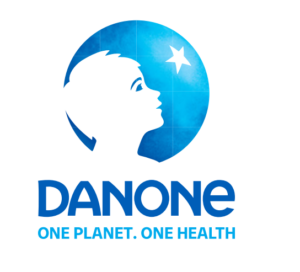
- F
Danone has extensive product labeling commitments to the use of both FOP and BOP labeling on its products. The company commits to displaying nutrition information online, accounting for country-specific differences in product compositions for all their products, globally. Displaying nutritional information for all products online shows transparency and enables consumers to check the nutritional content of products across the company’s portfolio in all markets.
-
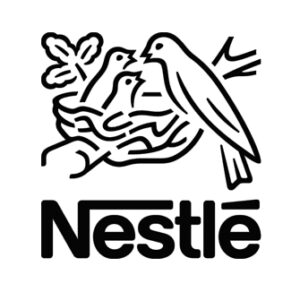
- F
Nestlé is the only company that commits to not use Nutrition and Health Claims in countries where local or national regulations are less strict than Codex Alimentarius Guidelines. Codex guidelines are international food standards, codes of practice, and recommendations established to protect the health of the consumers and to ensure fair practices by 188 member countries. The company is the only one that has a public commitment to use interpretive labeling on its products, globally.
Nestlé’s Claims Policy
Nestlé published its Claims Policy in 2016, in which includes a framework that extensively covers health and nutrition claims used in consumer communication. Beyond referring to their alignment with Codex standards, the company states that:- All claims must be compliant with local regulations or, where they do not exist, with Codex in addition to Nestlé governance rules and procedures.
- Claims must be substantiated. Specifically for health claims on food and beverages, the Nestlé Health Claims Panel, a central committee of internal experts, assesses whether the scientific substantiation follows Codex Alimentarius Standards.
In addition, for products carrying a health claim, linking it to the definitions of healthy products as defined in its NPM:
- Nutrition information labeling is mandatory.
- The Nestlé Nutritional Foundation criteria as defined by the Nestlé Nutritional Profiling System must be met.
- A statement about the importance of a balanced diet and a healthy lifestyle must be included in the labeling.
In addition, the company states that the policy applies globally and with the explicit scope to cover all products sold under brands owned by the company that carry a claim, including products sold by joint ventures and license partners.
-
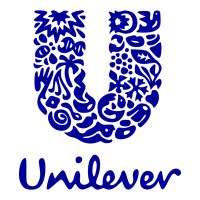
- F
On its global website Unilever in 2017, signed a CGF commitment to switch to standardized food expiry dates by 2020. The aim of this commitment is to tackle food waste by avoiding the confusion around date labels that often causes people to throw away good food. The company states ‘’We’re also using our brands to reach consumers – and helping them cut waste through great products and innovative ideas”.
The company has started an initiative developed in collaboration with the Too Good To Go partnership and industry players, which aims to reduce food waste at the consumer level. They are piloting a new method of date labeling in Denmark and Germany which involves placing a new packaging label directly after the ‘best before’ text on certain food products.
The new product labels will now read as: ”Best before ‘date’, ‘often good after ‘date”. The intention with initiatives such as this is to encourage consumers to take the second label information as guidance that the product may still be edible beyond its predetermined ‘best before’ shelf-life date.
Unilever’s Position on Nutrition and Health Claims
Unilever’s position on the use of health and nutrition claims is to provide consumers with ‘’relevant and concise nutrition information about products to help them make informed, healthier choices.’’ The nutrition and health claims are reviewed against a set of criteria which cover: :- Scientific substantiation of the claimed health relationship or benefit.
- Nutrient profile of the product making the claim.
- Unilever’s Food and Beverage Marketing Principles.
- Legal and regulatory frameworks.
Unilever uses ‘’Nutrient Profiles that are based on dietary recommendations to evaluate the overall nutritional composition of all our products. To define a product’s suitability for a nutrition or health claim, Unilever scores the product against Unilever’s Nutrition Criteria. The result determines if and what type of nutrition or health claims are acceptable on these products. We commit to make nutrition and health claims on fortified products only when they meet relevant Codex standards and the WHO/FAO Guidelines on Food Fortification with Micronutrients.’’
-
- F
The company stands out because of its broad commitment and public disclosure on the appropriate use of claims. The ‘Arla Foods’ labelling policy’ aims to ‘’create a uniform approach to packaging labelling with regards to the use of illustrations and information, including nutrition and health information, on all Arla Foods amba branded products, globally, to ensure simple and accurate product information to enable consumers to make informed dietary choices.’’
Arla has company specific nutrition criteria and states that they only allow the use of nutrition and health claims on products that meet these. The company commits to use national systems or guidance to get approval for nutrition and health claims and, if none exist, will only use claims in line with the Codex standards.
F1 Nutrition labeling
The average company score on nutrition labeling standards was quite low, at 4.6 out of 10. Danone leads with a score of 9, a significant improvement from 7.3 in 2018. This is mostly due to improvements in its commitments to the use of FOP and BOP labeling on its products, and its new commitment to use interpretive labeling on its products globally. Regarding the display of nutrients, Danone commits to show all nutrients according to Codex Alimentarius Guideline CAC/GL 2-1985, including fiber on product labels. Overall, 16 companies have made a commitment to publicly disclose information both FOP and BOP. Five companies commit to display information only BOP, and four companies have made no commitments regarding labeling.
Table 1 shows that, in 2021, 13 companies disclose their commitments to FOP labeling. Similar to 2018, six companies report having fully rolled out their FOP nutrition commitments in more than 80% of the countries they are active in (or >98% of products globally); although the companies that commit to do so have changed (see Table 1). ATNI estimates this means almost half of the companies have rolled out their FOP labeling commitments to more than 80% of products globally (this was not assessed in 2018).
The new Index shows that 16 companies now also display nutrition information on per serving or per portion size, whereas only nine did so in 2018.
The Global Index 2021 shows three companies (FrieslandCampina, Danone, and Nestlé) that commit to use interpretive labeling (see Box 1) do display nutritional information FOP for all products, and three (Unilever, Kellogg, and Arla) for some of their products globally (see Table 1). In 2018, none of the companies committed to this.
Arla, Nestlé and Unilever are the only three companies that commit not to use additional interpretive labeling or other information FOP that directly relates to the message of the mandatory FOP labeling (which may confuse or distract consumers or modify the effect of the mandatory labeling).
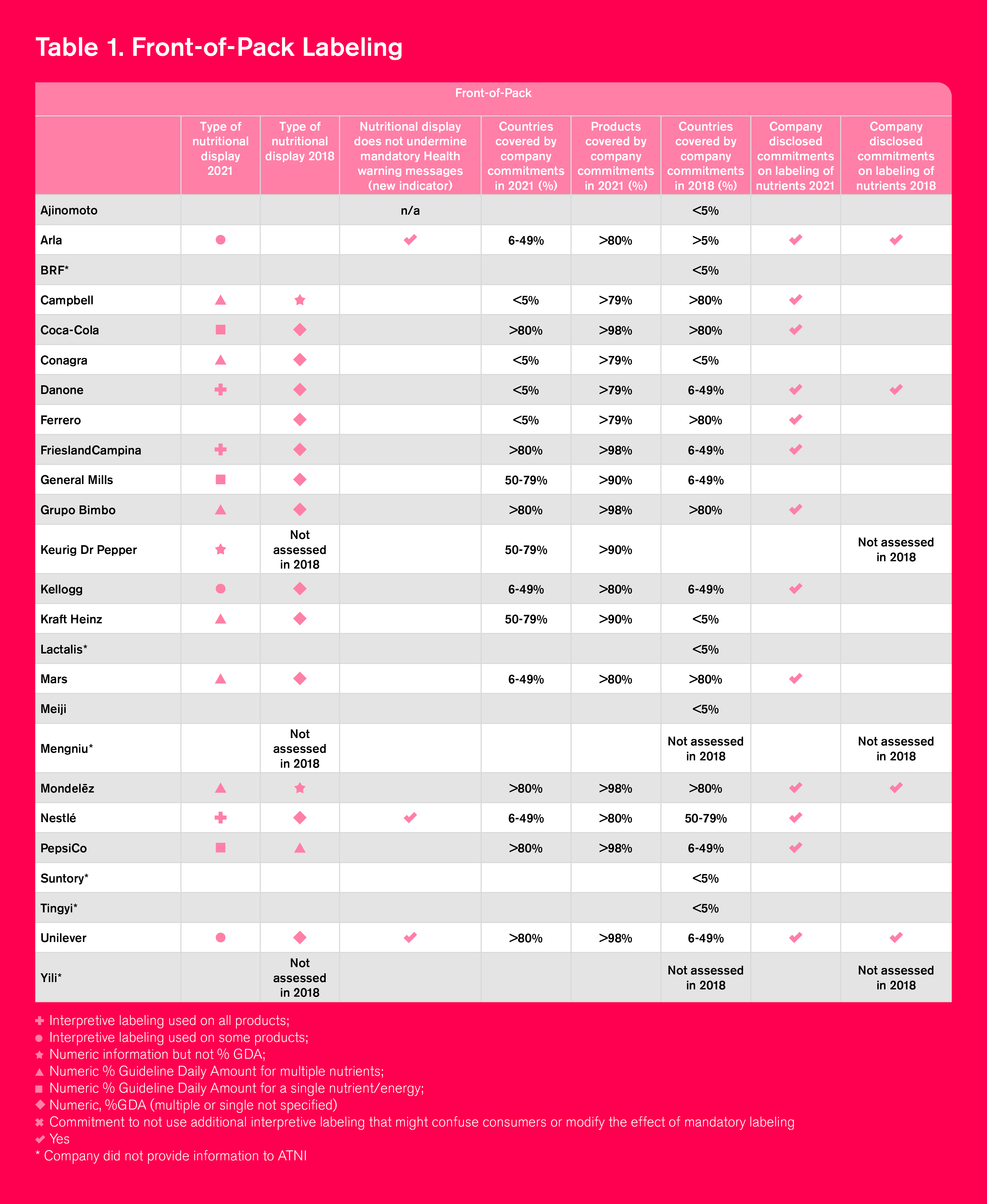
Table 2 shows an overview comparison of companies’ BOP commitments in 2021 and 2018. As can be seen, in 2021, 12 companies reported having fully rolled out their BOP nutrition labeling commitments in more than 80% of the countries in which they are active (or >98% of products globally); an increase from 10 in 2018. Of the 25 companies assessed in this Index, 16 publicly disclose their BOP commitments on labeling, compared to 14 in 2018.
In 2021, 14 companies publicly commit to — at a minimum — showing the nutrients recommended by Codex Alimentarius Guideline CAC/GL 2-1985 (i.e., energy value, protein, total carbohydrates, total sugars, total fat, saturated fat, and sodium) for products globally; with six companies extending that commitment to include fiber. No companies report mentioning added sugars on their labels.
Regarding BOP labeling of nutrients, 16 out of 25 companies disclose their commitments. Thirteen companies commit to providing BOP information on the quantity of nutrients as a percentage of the Guideline Daily Amounts (or similar measure) for all key nutrients and energy relevant for a specific market. Three companies do so for only a selection of key nutrients or energy.
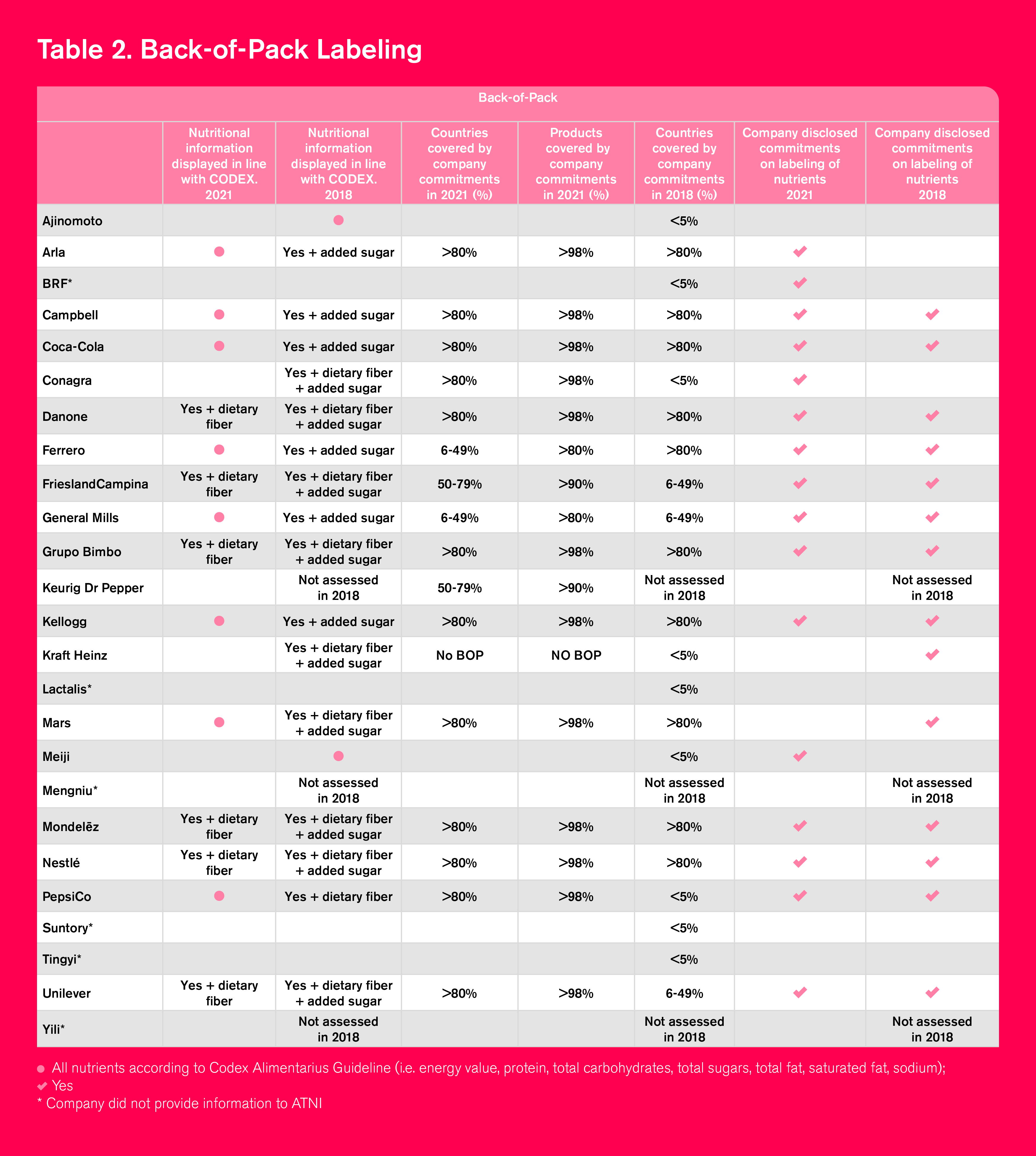
Many of the companies that express commitments to provide nutrition information on their labels are members of the International Food and Beverage Alliance (IFBA) and/or the Consumer Goods Forum (CGF), two global industry associations. By being a member or partner, companies pledge to the global nutrition labeling commitments as determined by the association. Although the industry associations arrange third-party auditing of responsible marketing to children’s commitments, third-party auditing of labeling compliance is not currently in place. Implementing these types of audits could raise credibility and transparency in nutrition labeling across a substantial part of the F&B industry.
With constant changes in regulations and labeling laws, consumers from all corners of the world struggle to navigate and interpret the meaning of different types of labels. Regarding the shelf-life of products, some labels include, but are not limited to, ‘’best before date’’, ‘’use by date’’, ‘’expiration date’’ or ‘’best if used by’’. Shelf-life labeling is determined by local laws and regulations, processing and packaging techniques, and advisory committees, among others. Confusion in interpretation of labels can lead to pre-disposal of large amounts of foodstuff before the actual expiration, referred to as food loss waste (FLW).
In an attempt to reduce FLW, in 2020, the Consumer Goods Forum (CGF), Board of directors adopted a call to action to simplify date labels on products in the US, UK and Japan, with hopes to unify this as a standard in countries across the world.
The Call to Action says retailers and food producers should take three important steps to simplify date labels and reduce food waste by 2020:
- Use only one label at a time.
- Have a choice of two labels: one expiration date for perishable items (e.g., “Use by”) and one food quality indicator for non-perishable items (e.g., “Best if used by”). The exact wording will be adapted to regional context.
- Educate consumers to better understand what date labels mean.
Although the majority of companies have shown they have a target or strategy in place to reduce FLW and provide commentary on this, some CGF members are yet to show examples of their labeling related measures to reduce FLW.
Food waste is a newly assessed topic in this category, therefore no comparisons to previous iterations can be made. However, companies’ current public strategies and targets aimed at combating food waste are assessed and reported on. Companies can reduce their FLW by improving and standardizing labeling practices.
Of the 19 companies for which information was available, six (Ajinomoto, Campbell, Danone, Meiji, Nestlé, and Unilever) have defined a labeling strategy and targets aimed at reducing food waste, and nine have defined either a strategy or targets. Eleven provided a commentary or technical information on their strategy/targets and 11 provided examples of labeling-related measures taken to reduce food waste beyond regulatory requirements (see Table 3).
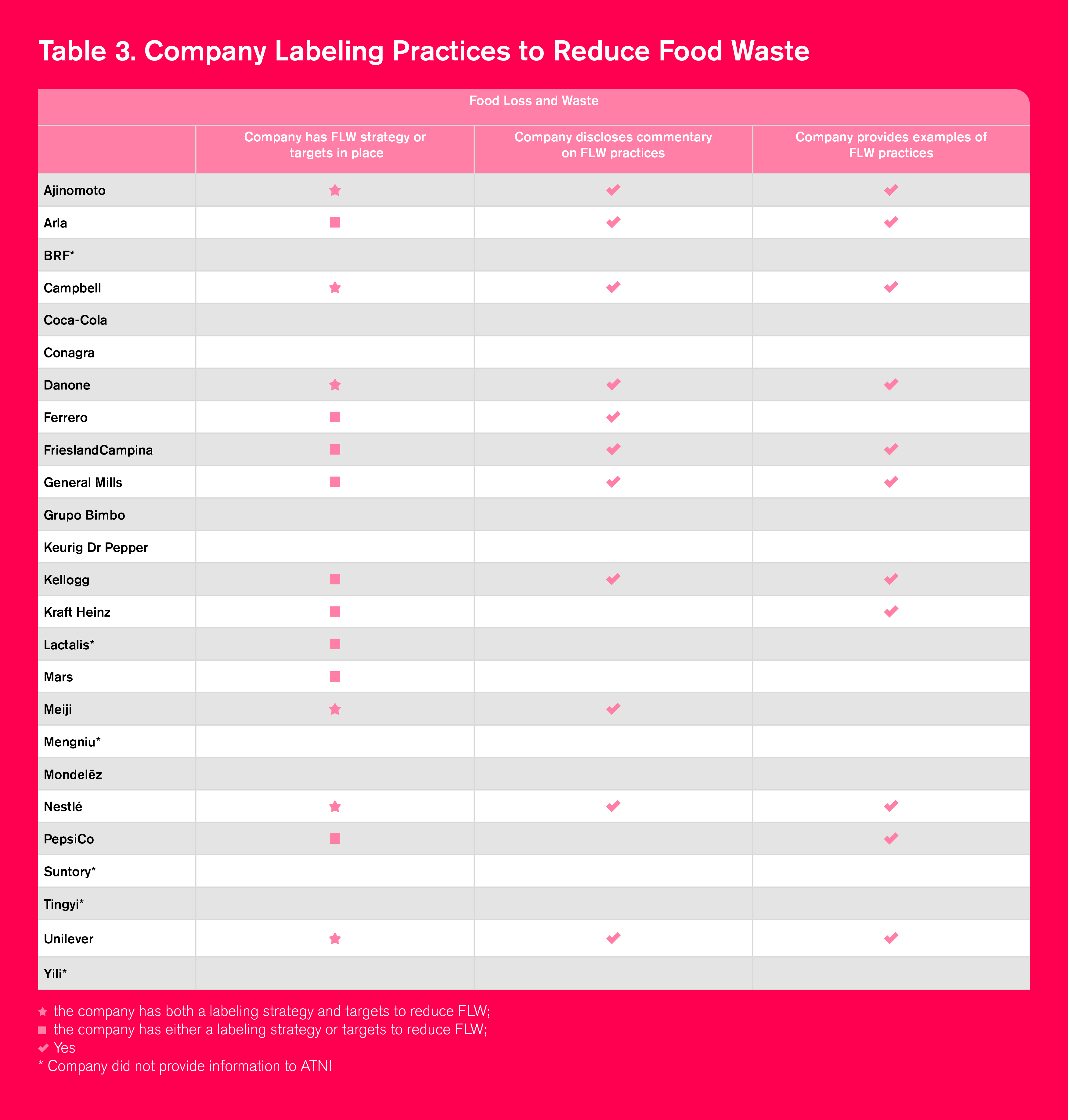
F2 Health and nutrition claims
Health and nutrition claims are often used on product packaging and in marketing communications. It is important that such claims are accurate, evidence based, and do not mislead consumers. Such claims should help consumers to make informed choices about what they eat. The use of health and nutrition claims is highly regulated in many high- or middle-income countries, but this is less so in low-income countries. Codex guidelines exist to advise the criteria that health and nutrition claims should meet. Therefore, in countries where no national regulatory system exists, ATNI encourages companies to use health and nutrition claims only when they comply with Codex guidelines.
In addition, health or nutrition claims should only be placed on healthy products as defined by a nutrient profile model (NPM). For that purpose, ATNI considers a Health Star Rating of 3.5 or higher, a NutriScore A or B, as equivalent, or a company specific NPM that has been validated objectively against these systems to determine the healthiness of a product.
A Nutrition claim refers to any representation that states, suggests, or implies that a food has a particular nutritional property. The following do not constitute nutrition claims:
a) The mention of substances in the list of ingredients.
b) The mention of nutrients as a mandatory part of nutrition labeling.
c) Quantitative or qualitative declaration of certain nutrients or ingredients on the label if required by national legislation.
Examples of nutrition claims are statements on products such as ‘source of calcium’ or ‘low in fat’.
A Health claim refers to any representation that states, suggests, or implies that a relationship exists between a food or a constituent of that food with health. It includes nutrient function claims, other function claims and reduction of disease risk claims.
Examples of health claims are statements on products such as ‘calcium may reduce the risk of osteoporosis’ or ‘vitamin D contributes to the normal function of the immune system’.
Nestlé and Unilever lead the rankings on the responsible use of health and nutrition claims with a score of 8.3, similar to 2018 (see Novelties and Best Practices above), and are followed by Mondelez, Mars, PepsiCo, and Arla. Nine companies (BRF, Conagra, General Mills, Yili, Keurig Dr Pepper, Lactalis, Mengniu, Suntory and Tingyi) show no sign of committing to international guidelines regarding the use of health and nutrition claims. Campbell receives a score in this 2021 Global Index for committing to comply with Codex guidelines when using health claims.
For countries without a national regulatory system, ATNI refers to Codex guidance. The number of companies that commit to following Codex guidance, in the absence of local regulation, increased from nine to 12 companies for both types of claims. Eight companies publicly disclose their commitments on health and nutrition claims, with Nestlé publishing its full ‘Policy on Nutrition and Health Claims’ and demonstrating industry best practice.
Despite progress since the previous iteration of the Index, less than half of the companies express commitments to use health and nutrition claims appropriately, which explains why the average score for this section remains low at 2.5 points.
Companies should only place health or nutrition claims on healthy products as defined by a relevant nutrient profiling model (NPM). ATNI assesses if companies have commitments in place to apply a NPM to assess product healthiness prior to using claims. This is in-line with international standards, to protect consumers from making choices based on misleading information. ATNI considers products as healthy if they achieve a Health Star Rating of 3.5 or higher, a Nutri-Score A or B, as equivalent, or company’s own NPM that has been validated objectively against these systems.
In this regard, industry best practice is for companies to commit to not nutrition claims on products without first determining the healthiness of the product by using a government endorsed NPM. None of the Index companies make this commitment in full. However, three companies have committed to using their own company specific NPM to assess their products’ healthiness, globally, and two companies commit to only use nutrition claims on products that meet their own nutrition criteria. Twenty companies have no commitments in place regarding the use of nutrition claims.
In relation to the use of health claims and defining healthy products with nutrient profiling models, no companies in 2021 have committed not to using them on products unless they were defined as healthy by a government endorsed NPM — similar to nutrition claims. Four companies (Ajinomoto, Arla, Nestlé and Unilever) state they will only use health claims when the product meets the nutrition criteria of its own formal internal NPM, and two companies claim to use them only when it meets the nutrition criteria of its own precursor to an NPM. Nineteen companies have made no commitment to refer to an NPM when using health claims.
ATNI believes companies should use nutrition or health claims on products that have been fortified with micronutrients only when they meet relevant Codex standards and the WHO/FAO Guidelines on Food Fortification with Micronutrients. In 2021, nine companies made public commitments to this effect; however, only seven publicly disclosed this commitment. Of the seven, Mondelez and Unilever are the only two that specify the commitment covers all their operations globally. This represents a slight improvement from 2018, when seven companies made the commitment.
Seven companies, three more than in 2018, disclose their commitment to using health and nutrition claims on products that have been fortified only when these products are compliant with Codex fortification guidelines, or the principles therein. These are Danone, Lactalis, Mars, Mondelez, Nestlé, PepsiCo, and Unilever. Lactalis’ and PepsiCo’s commitments are new, and Danone has progressed since 2018 by disclosing its commitment. Arla, Coca-Cola and FrieslandCampina have made a commitment, but they do not publicly disclose it.